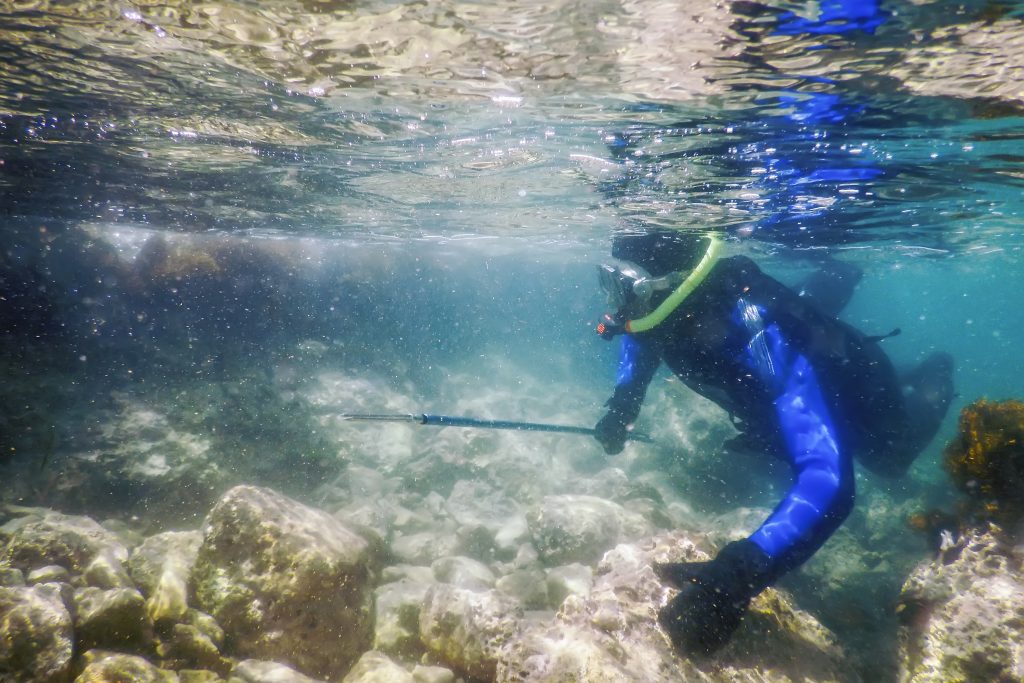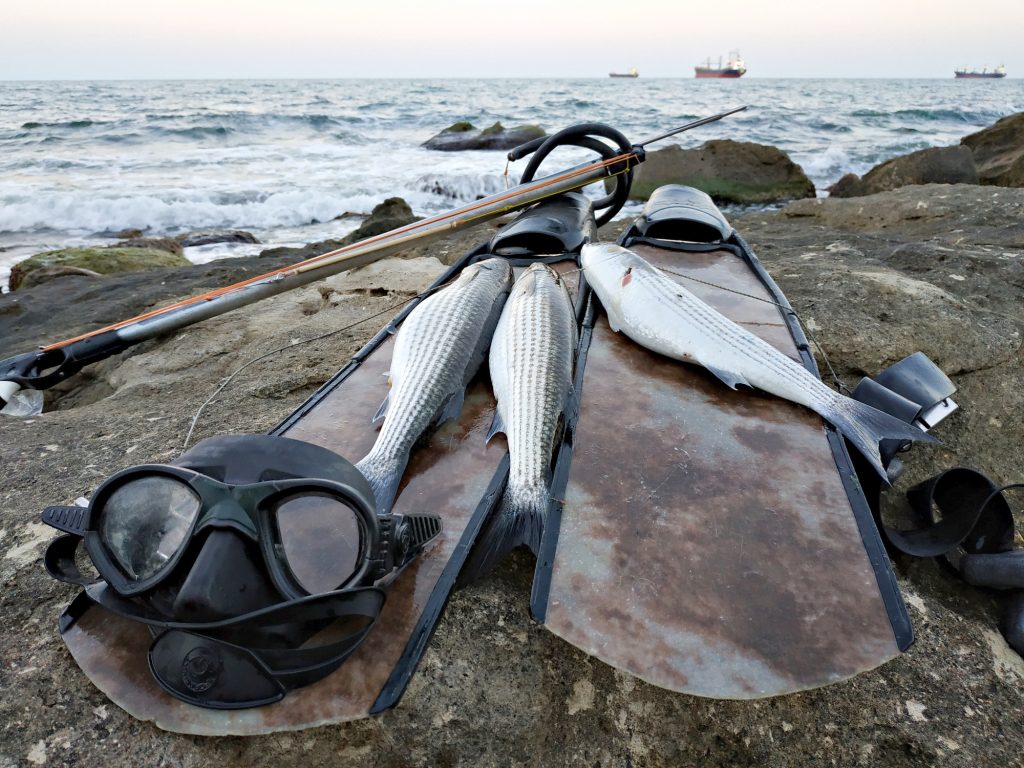What is spearfishing?
The sport of spearfishing is one of the oldest forms of fishing, dating back thousands of years when modern equipment was not available to assist more easily harvest fish. Modern progressions have brought us access to some of the greatest spearfishing gear at very reasonable costs.
The practice of spearing fish out of rivers and streams with sharpened sticks as a means of obtaining food is well-known to ancient civilizations.
Spearfishing has aided in the eradication of some non-native invasive species on the US and North American reefs.
Types of spearfishing
There are a few things to consider before attempting spearfishing. The first is that there are two types of spearfishing, one being free diving and the other being scuba diving without the use of a rebreather or oxygen.
It’s critical to be sure you’ve done enough training and are comfortable before attempting too much, as freediving is a very difficult activity.
The second, and more popular choice, is scuba diving. This is precisely what it sounds like: diving with scuba gear. People usually hunt lionfish with scuba to stay underwater and collect a large quantity of fish without needing to surface for air.
You’ll be snorkeling on the surface looking for fish, but if you’ve found your fish, this would be when you’d dive to get closer and then shoot the fish.

Why do people spearfish?
Due to this, as well as social media and YouTube, spearfishing has exploded in popularity. More and more people are becoming aware of the great natural resource that surrounds them and are doing their part to preserve species while also obtaining a delicious dinner.
People visit these reefs on a daily basis for a variety of reasons, including exploring the world’s largest living structure and filming them.
Some people hunt down fish for fun, business, or as a source of food. In tropical seas, some inhabitants spearfish in a snorkeling kit as a profession, frequently employing their own invented equipment.
What you need to spearfish in La Jolla
- Mask
- Snorkel
- Fins
- Wetsuit
- Weight belts
- Gloves
- Dive knife
- Speargun
- Fishing license
- Dive flag
To put it another way, the mask and snorkel are uncomplicated: you must be able to see and breathe underwater, do not use a snorkel when diving, and this is only for the surface.
The next step is to get a good wetsuit, which keeps your body temperature stable and protects you from the sun. Because your body is buoyant, adding a neoprene wetsuit makes you even more so.
To prevent this, you’ll need a decent weight belt. A good rule of thumb is to use enough weight so that your eyes are the only thing above the water.
The final few items are fins, which you’ll need to move through the water more quickly. Gloves and a dive knife are also essential accessories to bring; gloves are for protection and grip when catching fish, while a knife is for cutting line if you get caught in something.
You’ll also need some additional goods to complete the “fishing” aspect of this activity. The first is a fishing license, which you must have with you while spearing fish. Before ever getting into the water, double-check that you have all the required licenses and tags; you don’t want to get fined.
The second and third steps are a spear or speargun, which are two distinct sorts to choose from: a pole spear or speargun.
Before we go on to our basic gear, we must address one last thing: when diving, you must have a dive flag, which floats with a diver’s badge displayed. This indicates to other boaters that you’re in the water diving and that they should be careful.
A float is linked to your weapon or spear by a rope, so it follows you and gives you some indication of where you are in the water. Assume that you and a buddy are diving together while a third person is on board the boat monitoring your progress, therefore this dive flag also informs them of your position in the water, ensuring that you don’t stray too far from the ship.

Why is spearfishing illegal in some areas?
Spearfishing has traditionally harmed the environment when animals afraid or unaccustomed to divers were targeted excessively. However, it is also highly selective and contains a minimal quantity of by-catch; thus, spearfishing may be an environmentally sustainable type of fishing with education and appropriate restrictions.
What type of speargun should I use?
A pole spear is more difficult because you’re the one who’s putting power into the spear. Pole spears, or hand spears, are long shafts with a point on one end and an elastic loop on the other for propulsion. They’re available in a variety of materials, including aluminum or titanium metal, as well as fiberglass or carbon fiber. They’re frequently constructed out of smaller pieces that can be fastened together or collapsed for ease of carrying.
Spearguns are typically used in deeper water, while pole spears are more often utilized in shallower water. You’ll have to choose one of these based on the species you’re going after and the water you’ll be fishing in, just like any other typical fishing equipment.
A speargun is a gun that fires a spear underwater, often for the purpose of catching fish. Spearguns come in many shapes and sizes. Some use rubber bands, others use carbon dioxide gas or air. A speargun’s trigger mechanism keeps a spear in place along the barrel, regardless of whether it uses rubber bands or carbon dioxide gas, or air.
Tips for spearfishing in La Jolla, San Diego
When an experienced spearfisherman is on the bottom or in sight of a fish, he or she will keep still and the lack of sound in the water typically leads the fish to come close enough for him to strike. Shore spearfishermen may walk along the beach and prepare for an entry into the water before diving down and going straight to the bottom if they can hold their breath.
Experienced divers usually carry several tiny pieces of coral or shells with them and rubbing or clicking of these may often draw a fish closer. Sand-throwing up also draws a fish closer and helps to conceal the diver.
Contact with the coral should be avoided since this may harm the reef. Bluewater divers will float on the surface 100 yards from their boat and continue to rap a dive knife or a softer object against their spear gun until a big one comes to investigate.
A strong swimmer may clip his gun to his belt and force a fish into a hole by swimming full speed and smacking his cupped palms on the surface with each stroke in areas with many holes available for a fish to hide in.
For the larger ones, spearfishing is a popular hunting technique. The preferred prey of the desired species or collecting the seaweed, mussels, and other items they consume and chumming them into position are two options.
La Jolla Children’s Pool Spearfishing
The most popular spots in La Jolla for both novices and experts are the reefs. You may discover a variety of fish species just be cautious not to enter any marine protected areas. Visibility is great, beaches are simple to get to, and there are even kelp regions to be found.
- Address: 850 Coast Blvd, La Jolla, CA 92037
- Parking: There are no parking lots near the beach, and metered places fill up quickly, especially on weekends. Visitors are welcome to park in Downtown La Jolla and walk to the Children’s Pool in San Diego.
When is the best time to go spearfishing in San Diego?
Some fish, such as halibut or sheepshead, can endure all year. Winters, on the other hand, is when the best fishing conditions exist. In those months, from May to October, you’ll find far more yellowtails and Mahi than in any other season.
If you’re wondering about the best time of day, we recommend around sunset and sunrise. These are excellent times for the majority of fish species, as well as tides changing and coming tides.
The kelp beds, offshore banks, or kelp paddies are ideal places to find some excellent gamefish. If the water gets warm enough, you may land yellowtail, white seabass, tuna, and even mahi if you have access to a boat.
The year for these fish begins in early spring and gradually tapers off in October or November, depending on local water temperatures. Even though white seabass, yellowtail, mahi, and tuna are all gamefish, they must be hunted differently and use various types of gear configurations.
Conclusion for Spearfishing in La Jolla Children’s Pool
Spearfishing is a fantastic way to incorporate many elements of outdoor leisure into one activity. It’s also an excellent method to help control non-indigenous fish species while putting fresh food on the table. It’s a centuries-old art that’s only getting better and more accessible to learn.
One of the most appealing features of spearfishing is that there is no by-catch; you’re only capturing the target species, so no other fish are harmed.
If you’re searching for a new hobby, want to learn more about it, or meet some new individuals, spearfishing may be the sport for you. Our final note does not to dive alone; always have a partner handy; this could be a life-saving choice one day.
Water is stunning, but accidents may occur, and you don’t want to get trapped in a bad position with no assistance. So go out there, soak up the spectacular views, capture a delicious dinner, and make some new memories by doing something new!
Other articles you might like:



92 Comments
Comments are closed.